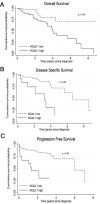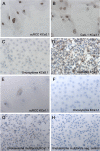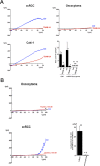High expression of KCa3.1 in patients with clear cell renal carcinoma predicts high metastatic risk and poor survival
- PMID: 25848765
- PMCID: PMC4388734
- DOI: 10.1371/journal.pone.0122992
High expression of KCa3.1 in patients with clear cell renal carcinoma predicts high metastatic risk and poor survival
Abstract
Background: Ca2+-activated K+ channels have been implicated in cancer cell growth, metastasis, and tumor angiogenesis. Here we hypothesized that high mRNA and protein expression of the intermediate-conductance Ca2+-activated K+ channel, KCa3.1, is a molecular marker of clear cell Renal Cell Carcinoma (ccRCC) and metastatic potential and survival.
Methodology/principal findings: We analyzed channel expression by qRT-PCR, immunohistochemistry, and patch-clamp in ccRCC and benign oncocytoma specimens, in primary ccRCC and oncocytoma cell lines, as well as in two ccRCC cell lines (Caki-1 and Caki-2). CcRCC specimens contained 12-fold higher mRNA levels of KCa3.1 than oncocytoma specimens. The large-conductance channel, KCa1.1, was 3-fold more highly expressed in ccRCC than in oncocytoma. KCa3.1 mRNA expression in ccRCC was 2-fold higher than in the healthy cortex of the same kidney. Disease specific survival trended towards reduction in the subgroup of high-KCa3.1-expressing tumors (p<0.08 vs. low-KCa3.1-expressing tumors). Progression-free survival (time to metastasis/recurrence) was reduced significantly in the subgroup of high-KCa3.1-expressing tumors (p<0.02, vs. low-KCa3.1-expressing tumors). Immunohistochemistry revealed high protein expression of KCa3.1 in tumor vessels of ccRCC and oncocytoma and in a subset of ccRCC cells. Oncocytoma cells were devoid of KCa3.1 protein. In a primary ccRCC cell line and Caki-1/2-ccRCC cells, we found KCa3.1-protein as well as TRAM-34-sensitive KCa3.1-currents in a subset of cells. Furthermore, Caki-1/2-ccRCC cells displayed functional Paxilline-sensitive KCa1.1 currents. Neither KCa3.1 nor KCa1.1 were found in a primary oncocytoma cell line. Yet KCa-blockers, like TRAM-34 (KCa3.1) and Paxilline (KCa1.1), had no appreciable effects on Caki-1 proliferation in-vitro.
Conclusions/significance: Our study demonstrated expression of KCa3.1 in ccRCC but not in benign oncocytoma. Moreover, high KCa3.1-mRNA expression levels were indicative of low disease specific survival of ccRCC patients, short progression-free survival, and a high metastatic potential. Therefore, KCa3.1 is of prognostic value in ccRCC.
Conflict of interest statement
Figures







Similar articles
-
Identification and validation of novel prognostic markers in Renal Cell Carcinoma.Dan Med J. 2017 Oct;64(10):B5339. Dan Med J. 2017. PMID: 28975890
-
High-level S100A6 promotes metastasis and predicts the outcome of T1-T2 stage in clear cell renal cell carcinoma.Cell Biochem Biophys. 2015 Jan;71(1):279-90. doi: 10.1007/s12013-014-0196-x. Cell Biochem Biophys. 2015. PMID: 25120023
-
Hypoxia-induced overexpression of stanniocalcin-1 is associated with the metastasis of early stage clear cell renal cell carcinoma.J Transl Med. 2015 Feb 12;13:56. doi: 10.1186/s12967-015-0421-4. J Transl Med. 2015. PMID: 25740019 Free PMC article.
-
Functional Roles of the Ca2+-activated K+ Channel, KCa3.1, in Brain Tumors.Curr Neuropharmacol. 2018;16(5):636-643. doi: 10.2174/0929867324666170713103621. Curr Neuropharmacol. 2018. PMID: 28707595 Free PMC article. Review.
-
KCa3.1 Channels and Glioblastoma: In Vitro Studies.Curr Neuropharmacol. 2018;16(5):627-635. doi: 10.2174/1570159X15666170808115821. Curr Neuropharmacol. 2018. PMID: 28786347 Free PMC article. Review.
Cited by
-
The Ion Channel-Related Gene Signatures Correlated With Diagnosis, Prognosis, and Individualized Treatment in Patients With Clear Cell Renal Cell Carcinoma.Front Pharmacol. 2022 Jun 1;13:889142. doi: 10.3389/fphar.2022.889142. eCollection 2022. Front Pharmacol. 2022. PMID: 35721115 Free PMC article.
-
Potassium Ion Channels in Glioma: From Basic Knowledge into Therapeutic Applications.Membranes (Basel). 2023 Apr 15;13(4):434. doi: 10.3390/membranes13040434. Membranes (Basel). 2023. PMID: 37103862 Free PMC article. Review.
-
SK4 channels modulate Ca2+ signalling and cell cycle progression in murine breast cancer.Mol Oncol. 2017 Sep;11(9):1172-1188. doi: 10.1002/1878-0261.12087. Epub 2017 Jun 26. Mol Oncol. 2017. PMID: 28557306 Free PMC article.
-
Transcriptome analysis of novel B16 melanoma metastatic variants generated by serial intracarotid artery injection.Acta Neuropathol Commun. 2025 Jan 16;13(1):10. doi: 10.1186/s40478-025-01924-1. Acta Neuropathol Commun. 2025. PMID: 39819494 Free PMC article.
-
Potassium Ion Channels in Malignant Central Nervous System Cancers.Cancers (Basel). 2022 Sep 29;14(19):4767. doi: 10.3390/cancers14194767. Cancers (Basel). 2022. PMID: 36230692 Free PMC article. Review.
References
-
- Wei AD, Gutman GA, Aldrich R, Chandy KG, Grissmer S, Wulff H et al. (2005) International Union of Pharmacology. LII. Nomenclature and molecular relationships of calcium-activated potassium channels. Pharmacol Rev 57: 463–472. - PubMed
-
- Wulff H, Kolski-Andreaco A, Sankaranarayanan A, Sabatier JM, Shakkottai V (2007) Modulators of small- and intermediate-conductance calcium-activated potassium channels and their therapeutic indications. Curr Med Chem 14: 1437–1457. - PubMed
Publication types
MeSH terms
Substances
LinkOut - more resources
Full Text Sources
Other Literature Sources
Medical
Miscellaneous

